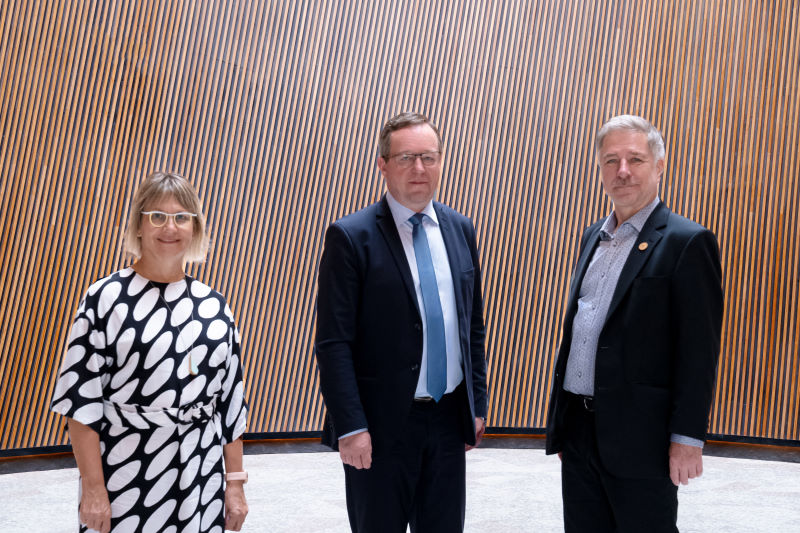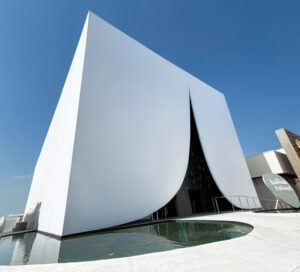This is the first in a series on the World Expo, in Dubai, in the context of the HVACR industry
The Red Line of the Dubai Metro from Centrepoint (formerly Al Rashidiya Station) terminates at the Expo 2020 Station, and I step out into the early-October sun, queue up to have my bag checked, just like at DXB, and make my way to the first rendezvous, the Finland Pavilion, an intriguing white structure – called the Snow Cape – in the Mobility District of the Expo venue.
It is an opportune visit, for His Excellency Mika Lintilä, the country’s Minister of Economic Affairs is present, as is Her Excellency Marianne Nissilä, the Finnish Ambassador to the UAE, Qatar and Bahrain.

L-R: H.E. Mika Lintilä, H.E. Marianne Nissilä and Severi Keinälä
Severi Keinälä, Commissioner General of Finland at Expo 2020 Dubai, is helming a Press meet, where H.E. Lintilä and H.E. Nissilä are key speakers. They elaborate on Finland’s excellent relationship with the UAE, and what it means to be present at the Expo. H.E. Lintilä, commenting on the importance of Expo 2020 Dubai for Finland’s bilateral relationship with the UAE, speaks of how the UAE is Finland’s second-biggest export country in the Middle East, after Saudi Arabia. “Expo 2020 Dubai,” he says, “provides a vital platform for Finland and our 120 partner companies [at the Finland Pavilion], enabling us to strengthen our shared goals in areas such as sustainability, education, digitalisaton and happiness. Together with the UAE and the global business community, we aim to co-create and innovate agile, sustainable and smart solutions for future business opportunities and societal development.”
H.E. Nissilä speaks on what Finland’s participation in the Expo means for local trade relations and FDI into Finland. “Expo 2020 Dubai,” she says, “brings the world together in hope and optimism for a better tomorrow. Finland and the host country, the UAE, have outstanding diplomatic and business relations. However, there is still scope for deepening them. We can achieve this through dialogue and learning from each other. Expo Dubai 2020 will act as a platform for this collaboration by bringing together various Emirati and Finnish stakeholders.”
She says Finland has every reason to believe the UAE sees Finland as an essential trading partner and a lucrative investment destination. “The next steps in developing economic cooperation and trade,” she says, “have already been designed – now it is time to move ahead.”
The theme of Finland’s participation in the Expo is ‘Sharing Future Happiness’. The country aims to showcase how Finland is pioneering sustainable change, developing digital innovations and adopting a circular economy model within businesses and society to help alleviate the current strain on the earth’s carrying capacity. The structure of the pavilion – designed by Finland-headquartered architectural firm, JKMM Architects – and the exhibits reflect the intent.

Snow Cape
Speaking on the Snow Cape structure, Teemu Kurkela, Founder, JKMM Architects, says that while designing, his team and he sought to bring a fragment of Finnish nature to the UAE. The pavilion, he elaborates, was inspired by the thin white layer of first snow that covers the Finnish landscape at the beginning of winter. “In Finnish, it is called ’Lumi’, which means snow,” he says. The main entrance of the Snow Cape, he reveals, was inspired by a traditional Arabic tent. “Two cultures meet in the architectural concept of the pavilion,” he says.
The entrance opens into The Gorge – a top-lit, shaded retreat with curved slatted wooden surfaces – which is quite the central feature of the pavilion. It is an outdoor feature, in that while the roof is covered, the entrance has no doorway to either prevent the ingress of hot air or the egress of mechanically cooled air. And yet The Gorge is cool even at mid-day.

Azzam Hunjul
The Gorge, also called the Wooden Heart, is the result of an integrated project development approach, says Gregor Turnsek, Competition Lead, JKMM Architects. We thought about energy efficiency and comfort from the very beginning of the concept, he says, adding that Halton Group, one of the partner companies of the pavilion, participated from the design stage. “It was important that we started early on to integrate their technologies to the design itself,” Turnsek says. “That’s what we value most that we have the possibility to talk to different engineers at the right time in the design process, and then the end result is better and it benefits the whole project.” Halton provided the displacement ventilation for The Gorge and the exhibition area, in the ground floor of the two-storeyed pavilion. The low-velocity, vertical-displacement air conditioning system, he says, is integrated into the main wooden wall of The Gorge. The system disgorges air from a low level, at a low velocity, keeping the air space for a height of two metres. “The Gorge is almost 15 metres in height, but with this smart technology we are cooling only the human level of the air, up to two or three metres or so,” Turnsek says. “So, it may just as well be 45 degrees C up there, while we are standing here in 23 degrees C. Naturally, by doing that, we are also limiting the energy consumption. Weighing in, Azzam Hunjul, Managing Director, Halton, says: “We have people up to two metres, and after that we don’t care if it is hot or not. We care about comfort of people but do not waste energy by cooling spaces that are high. We are cooling one third of the space, the volume, so we are saving 30-40% of the energy that is required.”
Besides relying on the air conditioning, JKMM Architects worked on achieving a good façade surface to volume ratio, which Turnsek says, further helps reduce the energy consumption. Adding to this, Samppa Lappalainen, CEO, Partner, JKMM Architects, says the firm tried to think of the architecture it was designing. The outer shell, he says, is relatively simple, with The Gorge being carved into the building. The shape of the gorge is such that there is no draught through the gorge, he says, so even it is a little bit windy outside, it doesn’t really make the air move rapidly inside. “The shape is optimal,” he says, “the colour [white] is optimal, in the sense that it reflects heat.”
Copyright © 2006-2025 - CPI Industry. All rights reserved.